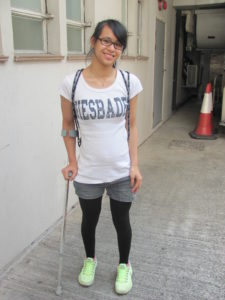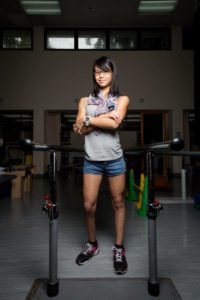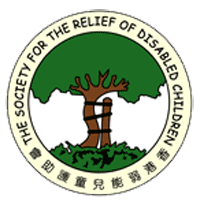ITB PUMP
 Lam Ka Yee suffered from cerebral palsy since the age of 6. She had spasticity in her legs, or an unusual tightness of muscles, making her walk clumsily known as the ‘scissors feet’. Ka Yee paid frequent visits to The Duchess of Kent Children’s Hospital at Sandy Bay during childhood to receive several surgeries and physiotherapies. She recalled that the experience was not much fun and pretty unpleasant as she was always tired physically and mentally. The worse was the treatment interrupted her study at school and she had to repeat Form 3 three times.
Lam Ka Yee suffered from cerebral palsy since the age of 6. She had spasticity in her legs, or an unusual tightness of muscles, making her walk clumsily known as the ‘scissors feet’. Ka Yee paid frequent visits to The Duchess of Kent Children’s Hospital at Sandy Bay during childhood to receive several surgeries and physiotherapies. She recalled that the experience was not much fun and pretty unpleasant as she was always tired physically and mentally. The worse was the treatment interrupted her study at school and she had to repeat Form 3 three times.
Unfortunately her muscle tone increased and caused more crouching and scissoring to her legs. Ka Yee had to use two elbow crutches when she walked. In her teenage she was discriminated and was called names while battling with the disability. Her doctors decided to go for a complicated treatment called ITB Pump implantation.
The device includes a tiny motor which moves the medication from the pump reservoir. In severe cases of spasticity, the medication can be administered through a pump that has been surgically implanted in the patient’s abdomen. The pump stores and releases prescribed amounts of medicine. The advantage is by delivering the medication directly to the spinal fluid, or known as “ITB”, it can deliver right to the target site in the spinal cord. The side effects are minimal.
Ka Yee admitted to DKCH in February 2012 to receive pre-surgery assessment on the medication. With the support of the Society for the Relief of Disabled Children, Ka Yee was able to receive the implant. The surgery was then completed on 20 November 2013 and the drug started to get into her spinal cord for leg control. She could get out of the bed the next day and walk independently!

In 2014, Ka Yee sat for the Diploma of Secondary Education (DSE) examination and could not continue the post-surgery training. This caused some setback on her leg movement and she had to admit again for adjusting the drug flow and also more intensive therapy.
In May 2015, Ka Yee had her medication in the pump replenished and her daily dosage was increased in July 2015. She continues her ongoing physiotherapy sessions.
SRDC is very pleased to know that very recently the pump is now available in public hospitals for free. To fulfill the mission of SRDC, we continue to allocate resources to support specific needs of children with disabilities, and filling the gaps which are not covered in the public healthcare system.
last update July 2015
